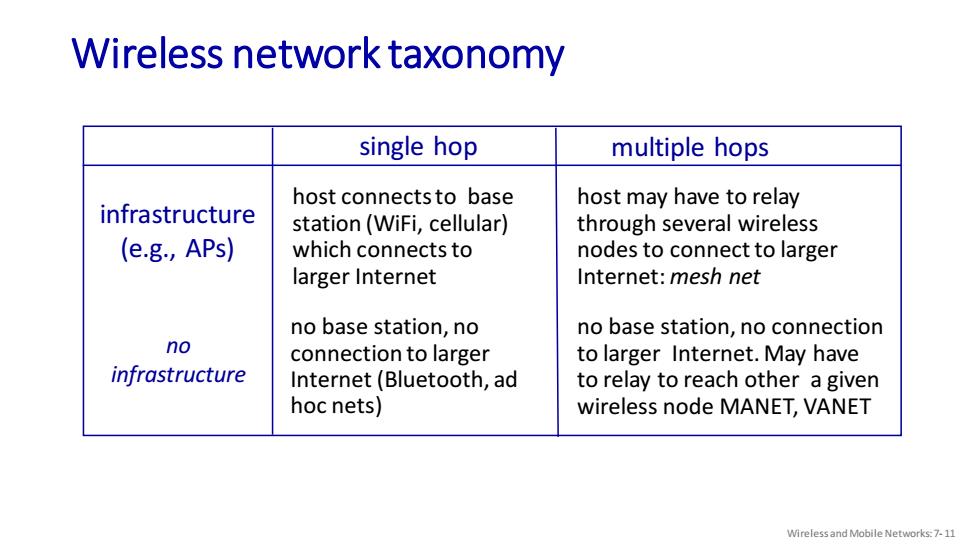
Wireless network taxonomy single hop multiple hops host connects to base host may have to relay infrastructure station (WiFi,cellular) through several wireless (e.g.,APs) which connects to nodes to connect to larger larger Internet Internet:mesh net no base station,no no base station,no connection no connection to larger to larger Internet.May have infrastructure Internet(Bluetooth,ad to relay to reach other a given hoc nets) wireless node MANET,VANET Wireless and Mobile Networks:7-11
Wireless network taxonomy Wireless and Mobile Networks: 7- 11 single hop multiple hops infrastructure (e.g., APs) no infrastructure host connects to base station (WiFi, cellular) which connects to larger Internet no base station, no connection to larger Internet (Bluetooth, ad hoc nets) host may have to relay through several wireless nodes to connect to larger Internet: mesh net no base station, no connection to larger Internet. May have to relay to reach other a given wireless node MANET, VANET
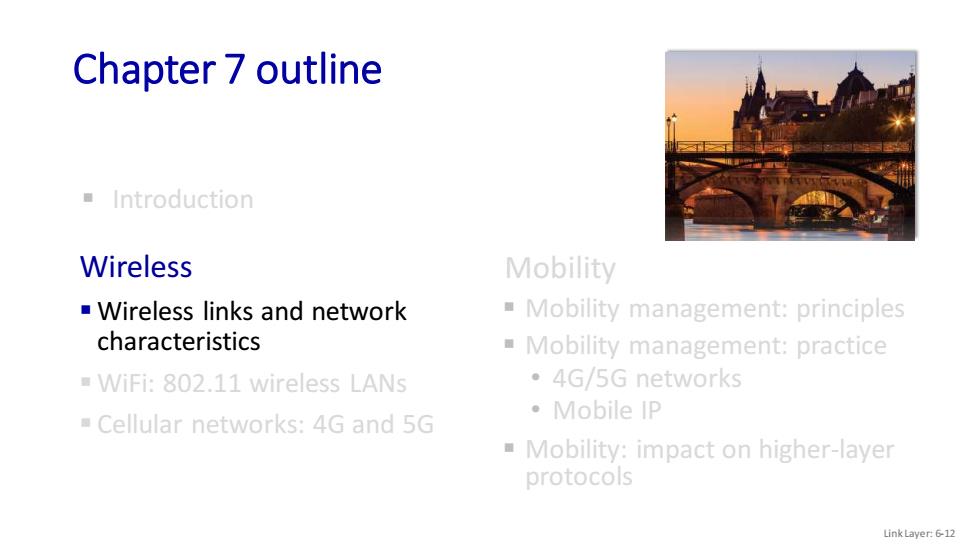
Chapter 7 outline ■Introduction Wireless Mobility Wireless links and network Mobility management:principles characteristics Mobility management:practice WiFi:802.11 wireless LANs ·4G/5 G networks 。Mobile IP Cellular networks:4G and 5G Mobility:impact on higher-layer protocols Link Layer:6-12
Chapter 7 outline ▪ Introduction Link Layer: 6-12 Wireless ▪ Wireless links and network characteristics ▪ WiFi: 802.11 wireless LANs ▪ Cellular networks: 4G and 5G Mobility ▪ Mobility management: principles ▪ Mobility management: practice • 4G/5G networks • Mobile IP ▪ Mobility: impact on higher-layer protocols
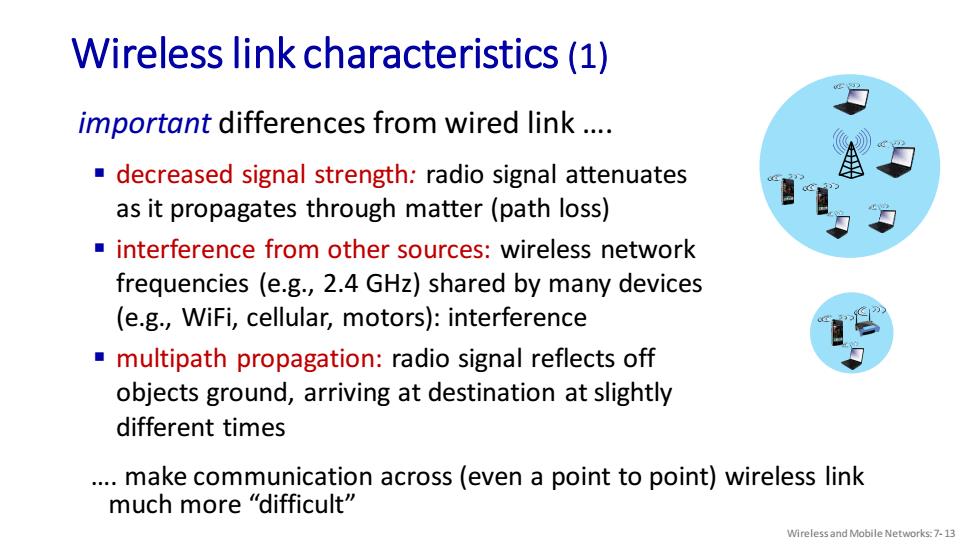
Wireless link characteristics(1) important differences from wired link ... decreased signal strength:radio signal attenuates as it propagates through matter(path loss) interference from other sources:wireless network frequencies (e.g.,2.4 GHz)shared by many devices (e.g.,WiFi,cellular,motors):interference multipath propagation:radio signal reflects off objects ground,arriving at destination at slightly different times ...make communication across (even a point to point)wireless link much more“difficult'" Wireless and Mobile Networks:7-13
Wireless link characteristics (1) Wireless and Mobile Networks: 7- 13 important differences from wired link …. ▪ decreased signal strength: radio signal attenuates as it propagates through matter (path loss) ▪ interference from other sources: wireless network frequencies (e.g., 2.4 GHz) shared by many devices (e.g., WiFi, cellular, motors): interference ▪ multipath propagation: radio signal reflects off objects ground, arriving at destination at slightly different times …. make communication across (even a point to point) wireless link much more “difficult
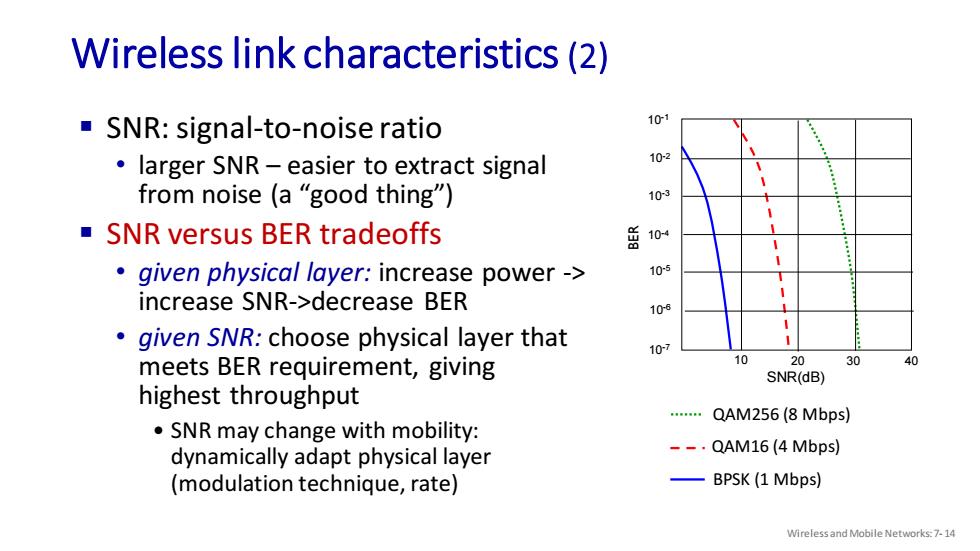
Wireless link characteristics(2) SNR:signal-to-noise ratio 10 larger SNR-easier to extract signal 10-2 from noise (a "good thing") 103 SNR versus BER tradeoffs 10-4 given physical layer:increase power-> 10-5 increase SNR->decrease BER 106 given SNR:choose physical layer that 107 meets BER requirement,giving 20 30 40 SNR(dB) highest throughput FAMNMn QAM256(8 Mbps) SNR may change with mobility: dynamically adapt physical layer --QAM16 (4 Mbps) (modulation technique,rate) BPSK(1 Mbps) Wireless and Mobile Networks:7-14
Wireless link characteristics (2) Wireless and Mobile Networks: 7- 14 ▪ SNR: signal-to-noise ratio • larger SNR – easier to extract signal from noise (a “good thing”) ▪ SNR versus BER tradeoffs • given physical layer: increase power -> increase SNR->decrease BER • given SNR: choose physical layer that meets BER requirement, giving highest throughput • SNR may change with mobility: dynamically adapt physical layer (modulation technique, rate) 10 20 30 40 QAM256 (8 Mbps) QAM16 (4 Mbps) BPSK (1 Mbps) SNR(dB) BER 10-1 10-2 10-3 10-5 10-6 10-7 10-4
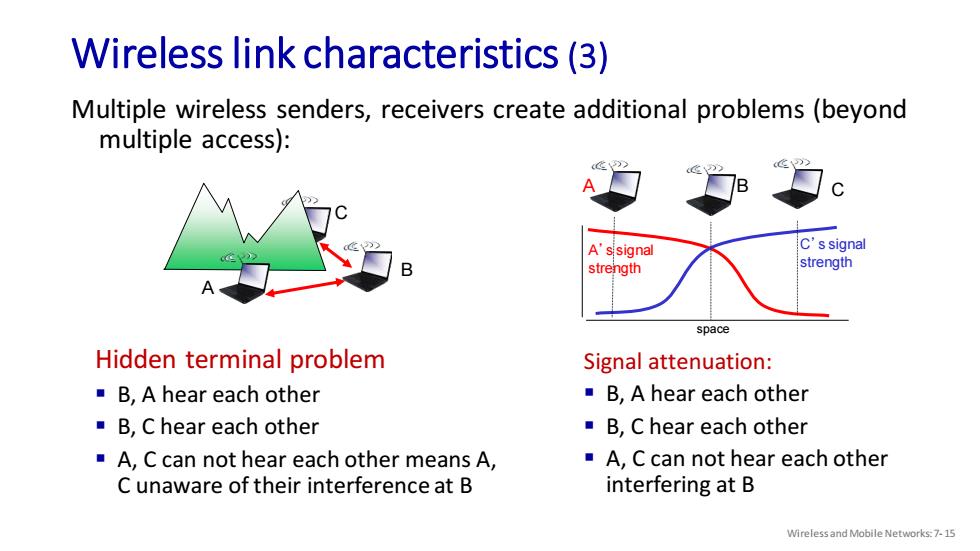
Wireless link characteristics(3) Multiple wireless senders,receivers create additional problems(beyond multiple access): A'ssignal C's signal strength strength space Hidden terminal problem Signal attenuation: ■B,A hear each other B,A hear each other B,C hear each other ■B,C hear each other A,C can not hear each other means A, A,C can not hear each other C unaware of their interference at B interfering at B Wireless and Mobile Networks:7-15
Wireless link characteristics (3) Wireless and Mobile Networks: 7- 15 Multiple wireless senders, receivers create additional problems (beyond multiple access): A B C Hidden terminal problem ▪ B, A hear each other ▪ B, C hear each other ▪ A, C can not hear each other means A, C unaware of their interference at B A B C A’s signal strength space C’s signal strength Signal attenuation: ▪ B, A hear each other ▪ B, C hear each other ▪ A, C can not hear each other interfering at B